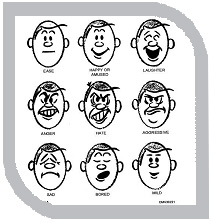Using Non-verbal signals
 Look for different behaviours
Look for different behaviours
If someone’s words do not match their non-verbal behaviors, you should pay careful attention.
For example, someone might tell you they are happy while frowning and staring at the ground. When words fail to match up with non-verbal signals, people tend to ignore what has been said and focus instead on non-verbal expressions of moods, thoughts, and emotions.
Ask questions about non-verbal signals
If you are confused about another person’s non-verbal signals, don’t be afraid to ask questions. A good idea is to repeat back your interpretation of what has been said and ask for clarification. An example of this might be, “So what you are saying is that…”
Use signals to make communication more effective and meaningful
Remember that verbal and non-verbal communication work together to convey a message. You can improve your spoken communication by using non-verbal signals and gestures that reinforce and support what you are saying. This can be especially useful when making presentations or when speaking to a large group of people.
Look at signals as a group
A single gesture can mean any number of things, or maybe even nothing at all. The key to accurately reading non-verbal behavior is to look for groups of signals that reinforce a common point. If you place too much emphasis on just one signal out of many, you might come to an inaccurate conclusion about what a person is trying to communicate.

Consider context
When you are communicating with others, always consider the situation and the context in which the communication occurs. Some situations require more formal behaviors that might be interpreted very differently in any other setting. Consider whether or not non-verbal behaviour is appropriate for the context. If you are trying to improve your own non-verbal communication, concentrate on ways to make your signals match the level of formality necessitated by the situation.
Be aware that signals can be misread
A firm handshake indicates a strong personality while a weak handshake is taken as a lack of stamina. This example illustrates an important point about the possibility of misreading non-verbal signals. A limp handshake might actually indicate something else entirely, such as arthritis. Always remember to look for groups of behaviour. A person’s overall demeanor is far more telling than a single gesture viewed in isolation.

A firm handshake indicates a strong personality while a weak handshake is taken as a lack of stamina.